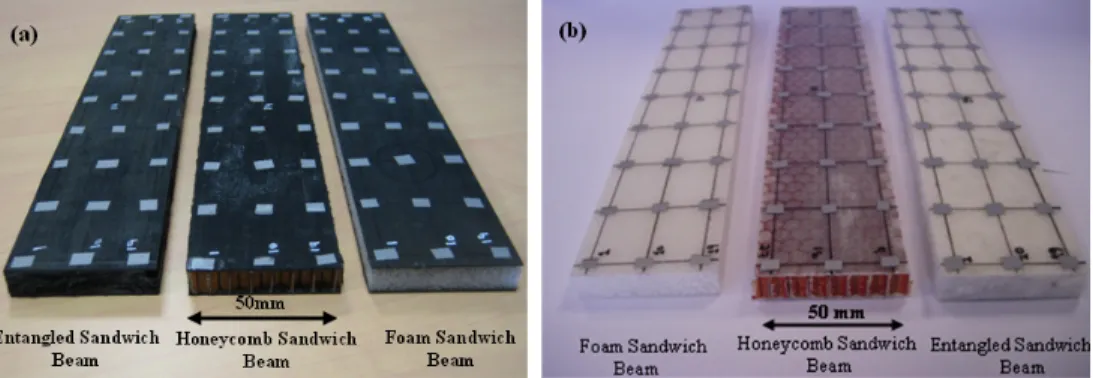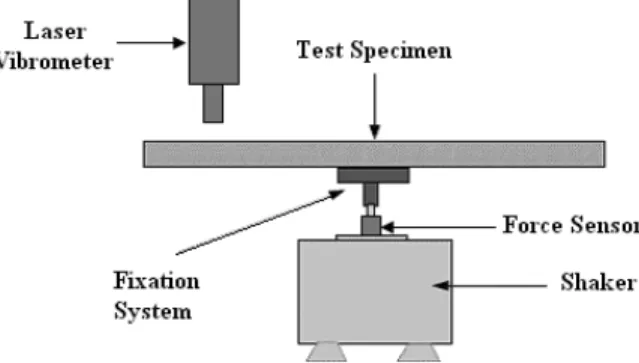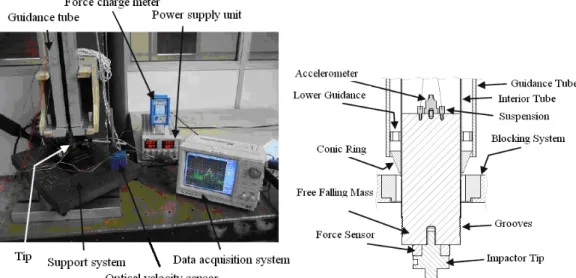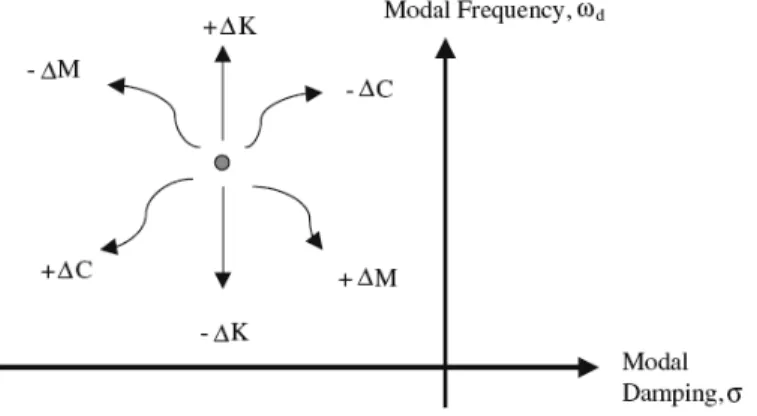HAL Id: hal-01852755
https://hal.archives-ouvertes.fr/hal-01852755
Submitted on 2 Aug 2018
HAL is a multi-disciplinary open access
archive for the deposit and dissemination of
sci-entific research documents, whether they are
pub-lished or not. The documents may come from
teaching and research institutions in France or
abroad, or from public or private research centers.
L’archive ouverte pluridisciplinaire HAL, est
destinée au dépôt et à la diffusion de documents
scientifiques de niveau recherche, publiés ou non,
émanant des établissements d’enseignement et de
recherche français ou étrangers, des laboratoires
publics ou privés.
Application of modal analysis for evaluation of the
impact resistance of aerospace sandwich materials
Amir Shahdin, Joseph Morlier, Guilhem Michon, Laurent Mezeix, Christophe
Bouvet, Yves Gourinat
To cite this version:
Amir Shahdin, Joseph Morlier, Guilhem Michon, Laurent Mezeix, Christophe Bouvet, et al..
Applica-tion of modal analysis for evaluaApplica-tion of the impact resistance of aerospace sandwich materials. IMAC
XXIX, A Conference and Exposition on Structural Dynamics : Advanced Aerospace Applications, Jan
2011, Jacksonville, United States. pp.171-177. �hal-01852755�
Application of Modal Analysis for Evaluation of the Impact Resistance of
Aerospace Sandwich Materials
Amir Shahdin*, Joseph Morlier1,*, Guilhem Michon*, Laurent Mezeix†, Christophe Bouvet* and Yves Gourinat*
* Université de Toulouse, ICA, ISAE, 10 av. Edouard Belin BP54032, 31055 Toulouse, France † Université de Toulouse, INPT-ENSIACET/CIRIMAT, 118 route de Narbonne, 31077 Toulouse, France
1 Corresponding author, Email: joseph.morlier@isae.fr, Phone no: + (33) 5 61 33 81 31, Fax no: + (33) 5 61 33 83 30
ABSTRACT
Impact resistance of different types of composite sandwich beams is evaluated by studying vibration response changes (natural frequency and damping ratio). This experimental works will help aerospace structural engineer in assess structural integrity using classification of impact resistance of various composite sandwich beams (entangled carbon and glass fibers, honeycomb and foam cores). Low velocity impacts are done below the BVID limit in order to detect damage by vibration testing that is hardly visible on the surface. Experimental tests are done using both burst random and sine dwell testing in order to have a better confidence level on the extracted modal parameters. Results show that the entangled sandwich beams have a better resistance against impact as compared to classical core materials.
Keywords
Structural Integrity Assessment, Composite Sandwich beams, Vibration Testing, Impact ResistanceIntroduction
The aim of composite sandwich structures is to increase the stiffness and specific strength and to reduce the weight so it is advantageous to employ them in aerospace applications where the challenge is to produce light structures. However damage due to impact in these structures may negate many of the benefits of sandwich construction. The facesheets can be damaged through delamination and fibre breakage; the facesheet and core interface region can be debonded and the core can be damaged through crushing and shear failure mechanisms. Safe and functional effectiveness of stressed sandwich structures can often depend on the retention of integrity of each of the different materials used in its manufacture. For aeronautical structures, a field where this problem has been quite studied, the components have to undergo low energy impacts caused by dropped tools, mishandling during assembly and maintenance, and in-service impacts by foreign objects such as stones or birds. In these low energy impacts normally, a small indentation is seen on the impact surface. This level of damage is often referred to as Barely Visible Impact Damage (BVID).
Although not visually apparent, low energy impact damage is found to be quite detrimental to the load bearing capacities of sandwich structures, underscoring the need for reliable damage detection techniques for composite sandwich structures. In recent years, vibration based damage detection has been rapidly expanding and has shown to be a feasible approach for detecting and locating damage [1-3]. Any structure can be considered as a dynamic system with stiffness, mass and damping. Once some damages emerge in the structures, the structural parameters will change, and the frequency response functions and modal parameters of the structural system will also change. This change of modal parameters can be taken as the signal of early damage occurrence in the structural system. Shift in natural frequency is the most common parameter used in the identification of damage [4-6]. However, in structures made of composite materials there seems to be a tendency to use
damping as a damage indicator tool, as it tends to be more sensitive to damage than the stiffness variations, mainly when delamination is concerned [7-10]. A comprehensive review of low-velocity impact responses of composite materials is presented by Richardson and Wisheart [11]. Dear et al. [12] studied the impact toughness of different lightweight sandwich panels and composite sheet materials. They emphasized on the degree of damage inflicted on the contact surface, through-thickness and rear surface of the materials when subjected to different impacts. Vaidya et al [13] studied composite sandwich structures composed of aluminum foam core and found it optimal for resisting low-velocity impacts. Similarly several novel sandwiches have been developed with a view to enhance the impact toughness [14-16].
In this paper we have made Low Velocity Impact (LVI) and post impact vibration tests to measure the impact resistance. More precisely we evaluated the resistance against impact of entangled sandwich materials in comparison with standard sandwiches with honeycomb and foam cores, uniquely based on vibration test results (i.e., decrease in natural frequency which signifies loss of rigidity, and increase in damping which corresponds to friction in damaged zones). Vibration tests verify the presence of high damping in the entangled sandwich specimens making them suitable for specific applications like the inner paneling of a helicopter cabin, even if the structural strength of this material is on the lower side.
Material and Specimen
Six sandwich beam specimens are studied in this article, Fig. 1. The main emphasis of this article is on the two entangled sandwich beams with carbon and glass fibers as core materials. The honeycomb and foam sandwich beams are only presented for comparison purposes. Therefore comparison with standard sandwich beams is essential in order to evaluate the performance of entangled sandwich materials.
Fig. 1 The six sandwich beams tested in this article with (a) carbon prepregs and (b) glass woven fabric as skin materials
Sandwich beams have entangled carbon fiber, honeycomb and foam as core materials. For the skin, three of them have unidirectional carbon-fiber/epoxy prepregs of T700/M21 (four plies each with a stacking sequence of [0/90/90/0]); the other three are made of glass woven fabric, impregnated with epoxy resin (two plies each with a total thickness of 0.5 mm containing 50 % of resin). The thickness of the skins in case of glass woven fabric is kept similar to carbon fiber skins. The honeycomb sandwich beams are made of Nomex-aramid honeycomb core (nominal cell size of 6.5 mm and a core thickness of 10 mm). In case of the foam sandwich beams, the foam core has also a thickness of 10 mm. The core, in case of the carbon entangled sandwich beam, consists of carbon fibers that are made of a yarn of standard carbon filaments having a diameter of 7 μm. The length of the carbon fibers is 10 mm and their elastic modulus is 240 GPa. In case of the glass entangled sandwich beam, the core consists of glass fibers made of glass filaments having a diameter of 14 μm. The length of the glass fibers is 10 mm with an elastic modulus of 73 GPa. For the cross-linking of carbon and glass fibers, epoxy resin and injection hardener are used. A better vaporization is achieved if the resin is heated up to 35°C before being sprayed on the carbon and glass fibers. This allows the mixture of resin and hardener to become less viscous. The fabrication of these entangled sandwich beams is a relatively complex process. The carbon and glass fibers are cut with the help of a fiber-cutting machine. A blow of compressed air then separates the fibers. The fibers vaporized by the resin are then placed in the mold between the two skins. A fiber core density of approximately 200 kg/m3 is chosen for the entangled sandwich core in case of both carbon
Experimental Methods
High quality vibration testsThe experimental equipment used for vibration testing is shown in Fig. 2. The experimental set-up is that of a free-free beam excited at its center, based on Oberst method [17]. The test specimen is placed at its center on a force sensor which is then assembled on a 100N electrodynamics shaker. The response displacements are measured with a non-contact and high precision laser vibrometer. The shaker, force sensor and the laser vibrometer are manipulated with a data acquisition system.
Fig. 2. Diagram of the experimental set-up
Each specimen is tested with two types of excitations: burst random and sine dwell. Response is measured at 27 points that are symmetrically spaced the length of the beam to have reliable identifiable mode shapes. Burst random excitation permits to have rapidly the overall dynamic response of the structure (natural frequencies and mode shapes). It is a broadband type excitation signal. 50% burst percentage is used for burst random excitation in the frequency range of 0-2650Hz. However if we need precise damping measurements then sine-dwell testing becomes inevitable. Its advantage is its capability of detecting non-linear structural dynamic behavior. As this method requires larger acquisition times, acquisition is carried out only around the first four bending modes previously identified by burst random testing.
The modal parameters are extracted for burst random and sine-dwell testing respectively. The estimation method is a new non-iterative frequency domain parameter estimation method based on weighted least squares approach. One of the specific advantage of this technique lies in the very stable identification of the system poles and participation factors as a function of the specified system order, leading to easy-to-interpret stabilization diagrams.
Low Velocity Impact tests
The sandwich beams tested in this article are damaged by drop weight impacts below the Barely Visible Impact Damage limit (BVID), in order to simulate damage by foreign impact objects. The impact tests are carried out by a drop weight system as shown in Fig. 3-a, and a detailed cut away of the drop assembly is shown in Fig. 3-b. The impactor tip has a hemispherical head with a diameter of 12.7 mm. A force sensor is placed between the impactor tip and the free falling mass of 2 kg. The velocity before the impact is measured with an optical velocity sensor from which the energy of impact can be verified.
Fig. 3. Arrangement of the test equipment for the impact test (a) and detailed cutaway of the drop assembly (b) The impact energy is chosen in such a way that each sandwich beam has approximately the same level of damage (i.e., below the BVID limit which is nearly invisible on the surface). The impact parameters and the indentation depths measured for the six sandwich beams are listed in Table 1. The data obtained during the drop weigh impact tests carried out on the beams are presented in Fig. 4. In Fig. 4-a and 4-b, the impact forces are drawn as a function of time for the six sandwich beams. These curves are globally smooth and almost sinusoidal at low impact energy. It can also be seen, from the force-displacement plots (Fig. 4-c and 4-d), that after the first damage in the classical sandwiches with honeycomb and foam cores, there is a decrease in the force signal followed by oscillations which signifies damage and loss of rigidity in the material. But in case of both glass and carbon fiber entangled sandwich beams (Fig. 4-c and 4-d), after the appearance of first damage the material continues to rigidify which is shown by a progressive increase of force signal. It can be observed from the force displacement curves of the honeycomb and foam core sandwiches (Fig. 4-c and 4-d) that the energy dissipation seems mostly due to the rupture mechanism. However in case of entangled sandwiches the behavior is different, it is possible that the energy dissipation might be predominantly due to damping as no oscillations or force signal loss is observed (i.e., no apparent damage signs).
Table 1. Impact test parameters of the sandwich beams
Indentation just after impact (mm) Type of Specimen Energy of
Impact (J) Point 1 Point 2 Velocity of impact (m/s) Entangled Carbon 4.9 0.1 0.15 2.21 Honeycomb Carbon 3.9 0.1 0.5 1.98 Foam Carbon 3.8 0.1 0.2 1.98 Entangled Glass 6.2 0.2 0.15 2.49 Honeycomb Glass 3.8 0.2 0.4 1.98 Foam Glass 3.8 0.15 0.25 1.98
Shift in modal parameters due to damage
The tested sandwich beams have two states. First one is the undamaged state (UD) and the second is the damage state due to two impacts (D1). Vibration tests are carried out on the six sandwich beams after each of these two states. The effect of impact damage on the modal parameters of the three types of sandwich beams is studied in the following sections with the help of frequency and damping changes between the undamaged (UD) and the damaged case (D1) defined by Eq. 1 and 2: Change in frequency between UD and D1, (Δf) = UD D
UD
f (k) f (k)
f (k)
−
1(1)
Change in damping between UD and D1, (Δ
ζ
) = D UDUD
(k)
(k)
(k)
ζ
− ζ
ζ
1 (2)where fUD(k) is the damped natural frequency for the undamaged specimen for the kth mode and fD1(k) is the damped natural
frequency for the specimen damaged at two impact points (D1) for the kth mode.
Fig.5. Sandwich test beams with location of the two impact points, 27 measurement points and one excitation point
(Point 14)
The effect of physical properties on poles in the complex s-plane is illustrated in Fig. 6. It can be observed that a change in stiffness affects only the frequency, while changes in mass and structural damping affect both modal damped frequency (ωd)
and modal damping (
σ
). For this study, the primary interest is to study the decrease in the modal damped frequency (ωd) andFig. 6. Movement of pole due to mass stiffness and damping effect
Results and discussions
Effect of impact damage on modal parameters
Frequency and damping ratios are the global parameters of the specimen, and are extracted from measurements carried out on the 27 measurement points. The modal parameters (natural frequency and damping) help in monitoring globally the health of a specimen. As a result of impact damage, there is a decrease in the natural frequencies for the six sandwich beams as discussed before in section 3.3. It can be noticed that this decrease is less prominent in case of both the carbon and glass entangled sandwich beams as compared to the honeycomb and foam sandwich beams. But the interesting fact is that for all the sandwich beams, even as the impact damage does not produce a visible damage on the surface, the change in frequency between the undamaged and the damaged cases is quite noticeable. This proves that there is a notable loss of rigidity without any signs of damage on the surface. The fact that the change in natural frequency between the damaged and the undamaged case is small in the entangled beams as compared to the foam and honeycomb beams can be seen in Fig. 7, which presents a comparison between the frequency response functions of the undamaged and the damaged cases for the six sandwich beams for the 1st bending mode. The frequency response functions presented in Fig. 10 are obtained with the sine-dwell testing. For the six sandwich beams, the shift in natural frequencies is slight in case of entangled sandwich beams proving that they have a loss of rigidity that is less pronounced as compared to the honeycomb and foam sandwich beams. Furthermore in case of the three carbon sandwich beams (Fig. 7-a), the frequency response functions of the carbon entangled sandwich beam are more acute (smaller in width) as compared to the honeycomb and foam sandwich beams. This phenomenon is less evident in case of the glass entangled sandwich beams (Fig. 7-b).
Fig. 7 Comparison of the frequency response functions estimated by sine-dwell testing for the undamaged case
(UD) and damaged at 2 points (D1) for the 1st bending mode for (a) Point 11 for the three carbon sandwich beams and
Therefore it can be concluded that the entangled sandwich beams show a better resistance to impact as compared to the honeycomb and foam sandwich beams, whereas all the beams have more or less the same level damage.
The shift in modal parameters is less in case of the entangled sandwich beams, which signifies that they possess better impact toughness as compared to the standard sandwich beams with honeycomb and foam as core materials. Furthermore, the results underline the fact that the damping change ratios are more prominent than the frequency change ratios. The maximum damping change ratio is 310 % whereas the maximum frequency change ratio is 25 %. It can be concluded from the above results that damping seems more sensitive to damage than the natural frequency variations in case of honeycomb sandwich beams. So it is reasonable to assume that damping may be used instead of natural frequency as a damage indicator tool for structural health monitoring purposes. However, the fact that damping is a parameter that is relatively difficult to estimate as compared to natural frequency has to be taken into account.
Conclusion
The aim of the article is to evaluate the resistance against impact of entangled sandwich beams by the pole shift which signifies loss of rigidity (decrease in natural frequency) and increase in friction in damaged zone (increase in damping ratio). A simple case of symmetrical impacts is studied and Low Velocity Impacts are done below the BVID limit in order to detect damage by vibration testing that is hardly visible on the surface. From the results it can be concluded that both carbon and glass fiber entangled sandwich beams show a better resistance to impact (based only on decrease in natural frequency) as compared to the honeycomb and foam sandwich beams, whereas all the beams have more or less the same level damage.
References
[1] Doebling SW, Farrar CR, Prime MB. A summary review of vibration-based damage identification methods. Shock and Vibration Digest, 30, 91-105, 1998.
[2] Yan YJ, Cheng L, Wu ZY, Yam LH. Development in vibration-based structural damage detection technique, Mechanical Systems and Signal Processing, 21, 2198-2211, 2007.
[3] E.P. Carden EP, P. Fanning P. Vibration based condition monitoring: A review, Structural Health Monitoring, 3(4), 355–377, 2004.
[4] Khoo LM, Mantena PR, Jadhav P. Structural damage assessment using vibration modal analysis. Structural Health Monitoring, 3(2), 177-194, 2004.
[5] Gadelrab RM. The effect of delamination on the natural frequencies of a laminated composite beam. Journal of Sound and Vibration, 197(3), 283-292, 1996.
[6] Yam LH, Cheng L. Damage detection of composite structures using dynamic analysis. Key Engineering Materials, 295-296, 33-39, 2005. [7] Shahdin A, Morlier J, Gourinat Y. Correlating low energy impact damage with changes in modal parameters: A preliminary study on composite
beams. Structural Health Monitoring 8(6), 523-536, 2009.
[8] Adams RD. Damping in composites. Material Science Forum, 119-121, 3-16, 1993.
[9] Gibson RF. Modal vibration response measurements for characterization of composite materials and structures, Composites Science and Technology, 60, 2769-2780, 2000.
[10] Saravanos DA, Hopkins DA. Effects of delaminations on the damped dynamic characteristics of composites. Journal of Sound and Vibration, 192, 977-993, 1995.
[11] Richardson MOW, Wisheart MJ. Review of low-velocity impact properties of composite materials. Composites Part A, 27, 1123-1131, 1996. [12] Dear JP, Lee H, Brown SA. Impact damage processes in composite sheet and sandwich honeycomb materials. International Journal of Impact
Engineering, 32, 130–154, 2005.
[13] Vaidya UK, Pillay S, Bartus S, Ulven C, Grow DT, Mathew B. Impact and post-impact vibration response of protective metal foam composite sandwich plates. Materials Science and Engineering A, 428, 59–66, 2006.
[14] Hosur MV, Abdullah M, Jeelani S. Manufacturing and low-velocity impact characterization of foam filled 3-D integrated core sandwich composites with hybrid face sheets. Composite Structures, 69(2), 167-181, 2005.
[15] Sutherland LS, Guedes Soares C. Impact characterisation of low fiber-volume glass reinforced polyester circular laminated plates. International Journal of Impact Engineering,, 31(1), 1-23, 2005.
[16] Abdullah MR, Cantwell WJ. The impact resistance of polyporopylene based fiber-metal laminates. Composites Science and Technology, 66(11-12), 1682-1693, 2006.
[17] Wojtowicki JL, Jaouen L. New approach for the measurements of damping properties of materials using oberst beam. Review of Scientific Instruments, 75(8), 2569-2574, 2004.




